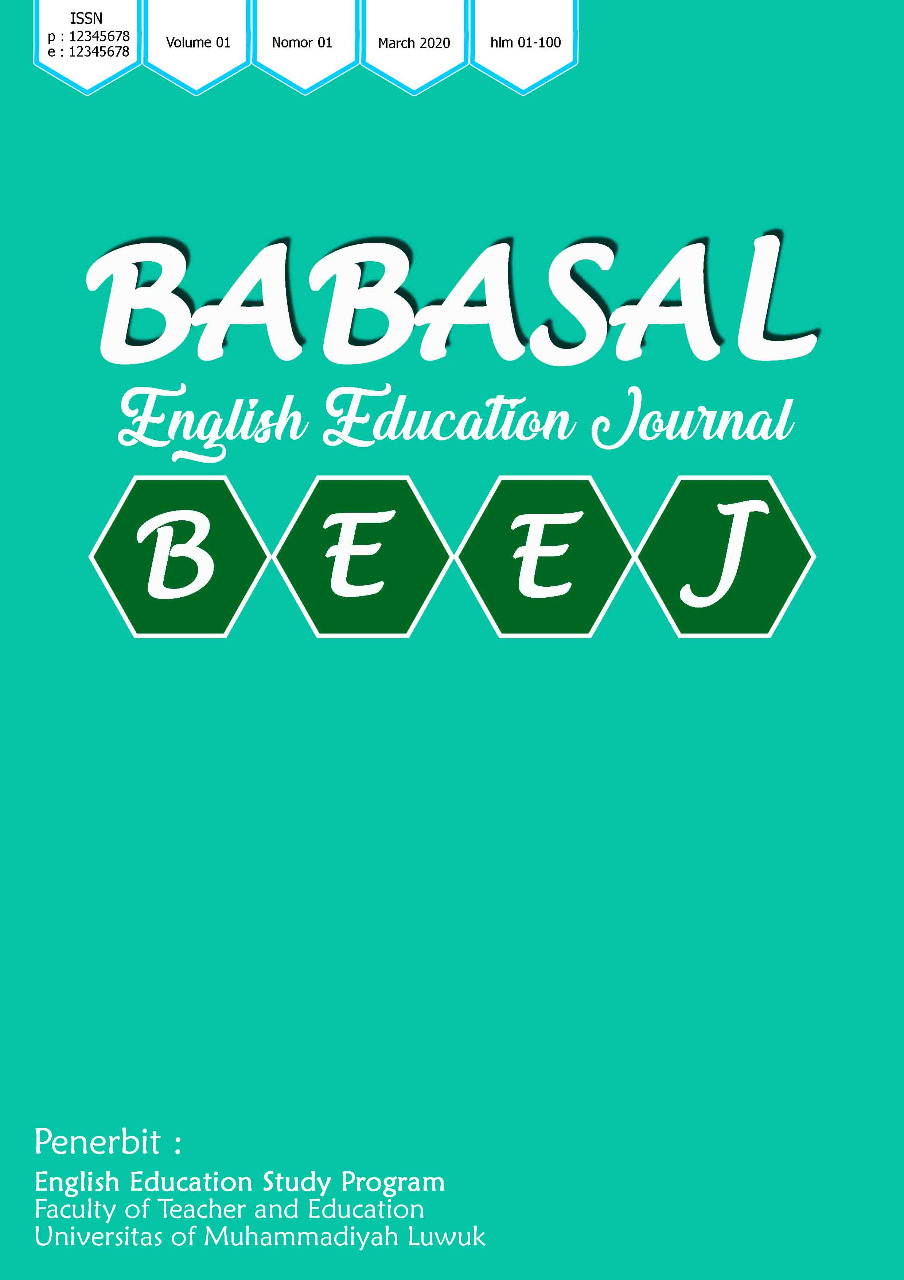The Obstacles Faced in Presenting ESP Procedure Text through Oral Presentation in the Business and Marketing Major
DOI:
https://doi.org/10.32529/beej.v5i2.3330Keywords:
Oral presentation, ESP, Procedure text, Marketing, BusinessAbstract
This study aimed to investigate the obstacles faced when presenting ESP procedure text through oral presentations in business and marketing majors and how to overcome those obstacles. This study used a case study design to understand the whole case in the totality of the environment. The subject of this study was an English teacher in a private Vocational High School (VHS) majoring in business and marketing in West Java, Indonesia. This study used two data collection techniques: observation and interview. The data was analyzed using thematic analysis. This study reported that there were several obstacles faced, such as the lack of students' readiness in presenting ESP procedure text through oral presentation (lack of confidence and lack of language mastery), lack of teacher's readiness in handling ESP teaching, and the mismatch between the given curriculum and the business and marketing students' need. Further, there were also several alternative solutions to overcome those obstacles, such as modifying the material and instructional model based on student's needs, using additional educational tools, and watching students' progress in preparing their oral presentations.
References
Adawiyah, D. (2021). The importance of English in business communication. Jurnal Adminika, 7(1), 178–186.
Ary, D., Jacobs, L. C., Sorensen, C., & Razavieh, A. (2010). Introduction to research in education (8th ed.). Wadsworth: Cenage learning.
Ati, A., & Parmawati, A. (2022). The use of oral presentation in teaching English to improve students speaking skill. PROJECT (Professional Journal of English Education), 5(2), 300. https://doi.org/10.22460/project.v5i2.p300-305
Basturkmen, H. (2010). Developing courses in English for specific purposes. Palgrave Macmillan.
Braun, V., & Clarke, V. (2006). Using thematic analysis in psychology. Qualitative Research in Psychology, 3(2), 77–101.
Brooks, G., & Wilson, J. (2014). Using oral presentations to improve students' English language skills. Humanities Review, 19, 199–212.
Dudley-Evans, T., & St. John, M. J. (1998). Developments in English for Specific Purposes: A multidisciplinary approach. Cambridge University Press.
Fitria, T. N. (2020). Teaching English for Specific Purposes (ESP) to the students in English Language Teaching (ELT). Jet Adi Buana, 5(1), 55–66. https://doi.org/10.36456/jet.v5.n01.2020.2276
Grubor, A., & Jaksa, O. (2018). Internet marketing as a business necessity. Interdisciplinary Description of Complex Systems, 16(2), 265–274. https://doi.org/10.7906/indecs.16.2.6
Hammad, E. A. (2020). The impact of oral presentations on Al-Aqsa University EFL students' speaking performance, speaking anxiety and achievement in ELT Methodology1. Journal of Second and Multiple Language Acquisition-JSMULA, 8(1), 1–27.
Huang, Z. (2023). Exploring effective teaching strategies for business English beginners. In Proceedings of the 2022 International Conference on Science Education and Art Appreciation (SEAA 2022). Atlantis Press SARL. https://doi.org/10.2991/978-2-494069-05-3
Hutchinson, T., & Waters, A. (1987). English for specific purposes: A learning-centered approach. Cambridge University Press.
Islama, A. W., Dzulfikri, D., & Nadzifah, W. (2022). Exploring the graduates' perception of English language materials in Vocational High Schools. EnJourMe (English Journal of Merdeka)?: Culture, Language, and Teaching of English, 7(1), 88–93. https://doi.org/10.26905/enjourme.v7i1.7445
Iswati, L., & Triastuti, A. (2021). Voicing the challenges of ESP teaching: Lessons from ESP in non-English departments. Studies in English Language and Education, 8(1), 276–293. https://doi.org/10.24815/siele.v8i1.17301
Marcu, N. A. (2020). Designing functional ESP (English for Specific Purposes) courses. Procedia Manufacturing, 46, 308–312. https://doi.org/10.1016/j.promfg.2020.03.045
Mardiningrum, A., & Ramadhani, D. R. (2022). Classroom oral presentation?: Students' challenges and how they cope. Eralingua: Jurnal Pendidikan Bahasa Asing Dan Sastra, 6(1), 103–119.
Melvina, & Alicia, D. (2016). Students' problems in giving presentation: A study at STKIP PGRI of West Sumatera. Proceedings of the Fourth International Seminar OnEnglish Language and Teaching (ISELT-4), 105–112.
Parmis, A. A., Pole, M. C. M., & Pinote, F. I. (2020). Students' oral presentation: Personality traits, difficulties, and speaking proficiency. International Journal of Current Research, 12(1), 9752–9756. https://doi.org/10.24941/ijcr.37818.01.2020
Pawiyati, T., & Pramono, R. P. (2022). Improving students' ability in speaking of procedural text with balabolka ('Text to Speech'). ELite Journal?: International Journal of Education, Language, and Literature, 2(2), 2022. https://journal.unesa.ac.id/index.php/elite
Pei, X., & Milner, J. O. (2016). Problems in transforming EGP teachers in China's universities into ESP teachers. Theory and Practice in Language Studies, 6(11), 2102. https://doi.org/10.17507/tpls.0611.06
Petraki, E., & Khat, K. (2020). Challenges and constraints in the design of an ESP course in Cambodia: Implications for higher education institutions. Asia Pacific Journal of Education, 1–6. https://doi.org/doi:10.1080/02188791.2020.1798738
Poedjiastutie, D. (2017). The pedagogical challenges of English for specific purposes (ESP) teaching at the University of Muhammadiyah Malang, Indonesia. Educational Research and Reviews, 12(6), 338–349. https://doi.org/10.5897/ERR2016.3125
Poedjiastutie, D., & Oliver, R. (2017). ?English Learning Needs of Esp Learners: ?Exploring Stakeholder ?Perceptions At an Indonesian University. TEFLIN Journal - A Publication on the Teaching and Learning of English, 28(1), 1. https://doi.org/10.15639/teflinjournal.v28i1/1-21
Rao, C. S. (2019). English for business purposes: An ESP approach. Journal for Research Scholars and Professionals of English Language Teaching, 3(15), 1–23.
Rawat, A. V. (2021). Role of English language as business language. Modern Management, Applied Science & Social Science (IJEMMASSS), 03(01), 281–284.
Riadil, I. G. (2020). Does oral presentation affect the development of the students' ability to speak in EFL classroom? Social Sciences, Humanities and Education Journal (SHE Journal), 1(2), 13. https://doi.org/10.25273/she.v1i2.6622
Rifiyanti, H., & Hardianti. (2023). Enhancing English Language Skills for Computer. BABASAL English Education Journal, 4(1), 13–20.
Sampath, D., & Zalipour, A. (2009). Practical approaches to the teaching of English language. Proceedings of the 2nd International Conference of Teaching and Learning, 1–14.
Sari, F. (2018). The issues of ESP instruction for university level in Indonesia. Global Expert: Jurnal Bahasa Dan Sastra, 7(1), 1–6.
Sucia, D. L., Rohman, A., & Pane, W. S. (2023). Students' perspective on challenges in English oral presentation?: A case study. Inquest Journal, 01(2), 72–77.
Vo, V.-L., Le, V.-Q., Nguyen, P.-T., Nguyen-Thi, T.-V., Tran-Thien, G.-P., & Tran-Chi, V.-L. (2020). Communication skills among business undergraduate students: Evidence from Vietnamese students. International Journal of Educational Sciences, 28(1–3), 24–28. https://doi.org/10.31901/24566322.2020/28.1-3.1112
Waluyo, B., & Rofiah, N. L. (2021). Developing students' English oral presentation skills: Do self-confidence, teacher feedback, and english proficiency matter? Mextesol Journal, 45(3), 1–17.
Yin, R. K. (2018). Case study research and applications: Design and methods. In Angewandte Chemie International Edition, 6(11), 951–952. (6th ed., Issue Mi). SAGE Publications, Inc.
Downloads
Published
Issue
Section
License
Copyright (c) 2024 Khairul Azmi Siagian, Sri Hartiningsih

This work is licensed under a Creative Commons Attribution-NonCommercial 4.0 International License.



